Loud music blaring at midnight. Dogs barking at all hours. Noisy neighbors can make home feel like a war zone instead of a peaceful sanctuary.
Stomping footsteps overhead.
But you don’t have to suffer endless noise pollution from inconsiderate neighbors.
With strategic use of acoustic panels combined with soundproofing treatments, you can effectively muffle disruptive sounds and restore tranquility.
Let’s explore how acoustic panels work and a layered approach to finally get relief from noisy neighbors.
Let’s dive in.
How Do Acoustic Panels Muffle And Reduce Noise?
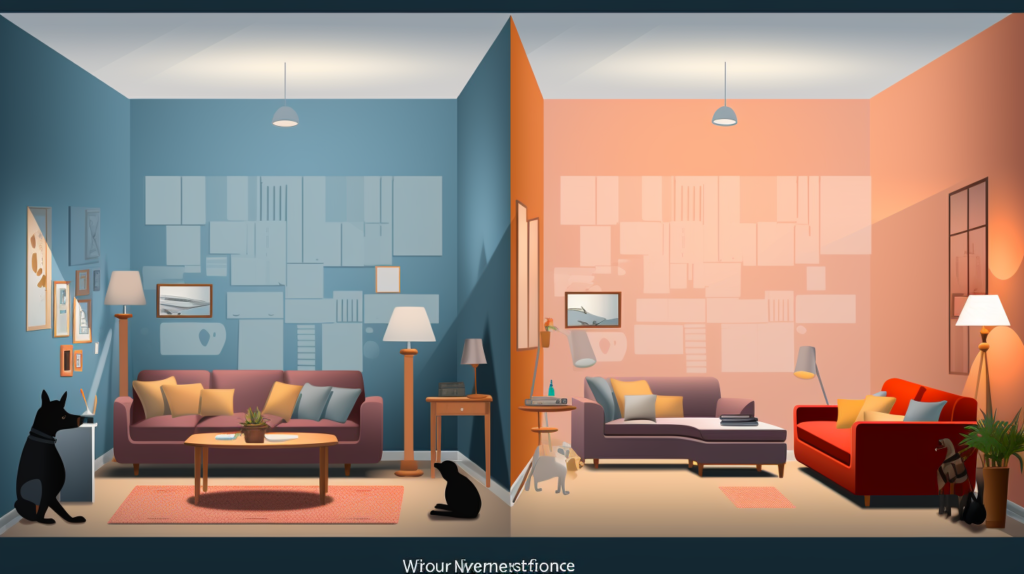
Acoustic panels are made of sound-absorbing materials such as fiberglass, mineral wool, cotton, or open-cell foam to take in sound waves rather than reflecting them back into a room.
When excessive noise hits these soft, porous absorber materials, the sound energy is transformed into heat as the materials vibrate from the sound waves.
This absorption reduces reverberation and muffles unwanted noises. Acoustic panels work by absorbing mid to high frequency sound waves. They are less effective at absorbing lower frequencies.
Using Acoustic Panels to Reduce Noise
Acoustic panels are mounted on walls, ceilings, or floors using adhesive, nails, Velcro, or other mechanical fasteners.
Positioning acoustic panels at optimal locations in a room blocks the transmission of noise through the air.
Whether you’re trying to reduce noise from upstairs neighbors, next door neighbors, or exterior sounds, acoustic panels can help absorb and diffuse sound.
However, acoustic panels are not very effective at reducing the impact of noises like footsteps, slamming doors, or items being dropped on the floor above.
Limits of Acoustic Panels for Noises
The dense mass required to effectively block impact noises would be too heavy to mount on walls.
For best reduction of impact noises, full soundproofing with mass-loaded vinyl, double drywall, and isolation clips is recommended.
But acoustic panels can significantly help reduce many common airborne noises from noisy neighbors like voices, music, dogs barking, and TV sounds.
They work by absorbing the sound waves rather than reflecting them back into the room.
Where To Place Acoustic Panels To Reduce Neighbor Noise

Identifying the main paths where noise enters from noisy upstairs neighbors or next door neighbors is key for optimal acoustic panel placement.
Shared walls and ceilings that are directly adjoining noisy areas in adjacent units should be prioritized for acoustic panel installation.
Acoustic panels should cover large sections of these noise transmission areas for best absorption and diffusion of the sounds.
Strategic Acoustic Panel Placement
Pay attention to electrical and plumbing utilities running through walls and ceilings as well when mapping out acoustic panel placement.
For upstairs neighbors, placing acoustic panels directly on the ceiling below noisy areas like below a neighbor’s stomping feet or loud TV can make a significant difference in reducing noise pollution.
For next door neighbors, the shared walls are often the most critical area for noise intrusion.
Getting Noise Relief from All Sides
Acoustic panels on multiple surfaces may be needed for sufficient noise reduction, such as on both walls and ceilings in a living space or recording studio.
Focus on blocking the direct paths where conversations, music and other disruptive noises enter from outside.
Strategically place acoustic panels to prevent sound waves from traveling directly through walls, floors or ceilings into your space.
Acoustic Panel Options To Muffle Neighbor Sounds

There are many acoustic panel products on the market to evaluate for your specific needs.
Choosing acoustic panels made with denser absorber materials will increase sound absorption and blocking capacity.
Acoustic panel thickness also impacts effectiveness, with most ranging from 1-2 inches thick.
Acoustic panels made of denser materials in 2 inch thickness will generally provide the highest level of noise reduction.
Customizing Your Acoustic Panels
Acoustic panels come in various mounting styles such as free-hanging suspended panels or wall-mounted panels.
For installation on ceilings and walls, mounted acoustic panel options often work best to fully cover the surface.
Fabric wrapped acoustic panels are recommended for improved aesthetics in visible locations.
The fabric covering will not significantly degrade the noise absorption if it has an air gap behind it and is not excessively thick or porous.
Choosing the Right Acoustic Panel
A variety of colors, textures, and prints are available to coordinate with existing décor.
Professional acoustic panel manufacturers will have noise blocking ratings like NRC clearly specified to compare products and ensure you get sufficient sound absorption.
Installing Acoustic Panels Yourself To Reduce Noise
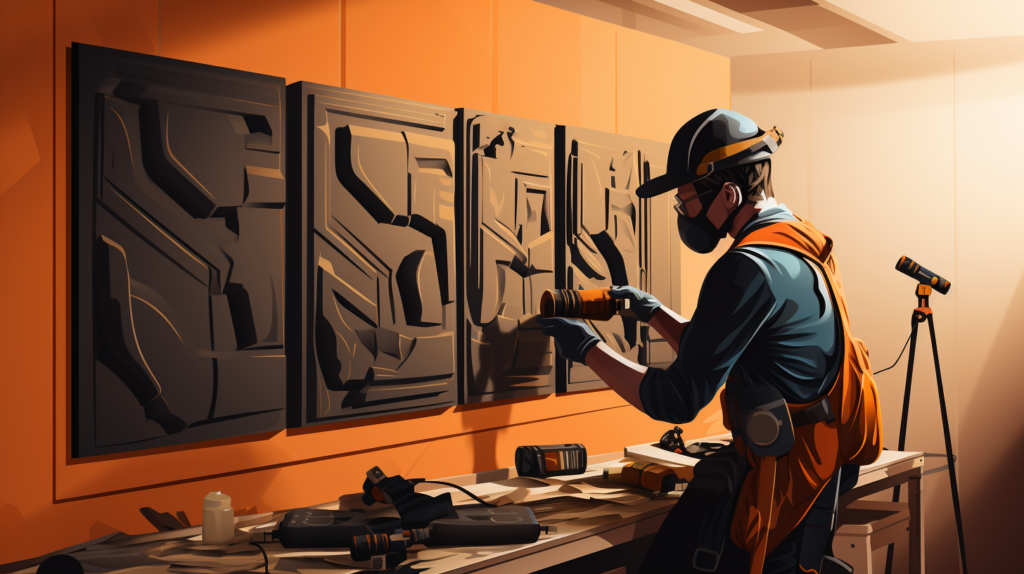
Acoustic panels can be installed DIY if you are comfortable using basic tools and following instructions carefully.
Use the manufacturer guidelines for the specific mounting method recommended for the acoustic panels purchased.
Most acoustic panels will use some combination of adhesive, nails, screws, or Velcro-type fasteners to attach them.
Mounting Acoustic Panels
Ensure acoustic panels are securely attached with no sagging and maintain an air gap behind each panel for proper performance.
Professionally installing acoustic panels is recommended if the ceiling height is over 10 feet or working on high ladders makes you uncomfortable.
Proper safety gear like gloves, goggles and a mask when cutting acoustic panels is very important.
DIY Acoustic Panel Installation
Measure carefully and use a level to ensure consistent alignment on your walls or ceilings.
Cut acoustic panels with a sharp utility knife on a flat, clean surface if needed to fit your space. Set up a stepladder or scaffolding to comfortably reach all areas and move it as you install.
Work slowly and deliberately for best results. Hiring an experienced acoustic panel installer is advisable if you lack the tools, time or confidence for a DIY installation.
Can Acoustic Panels Really Provide Noise Relief?
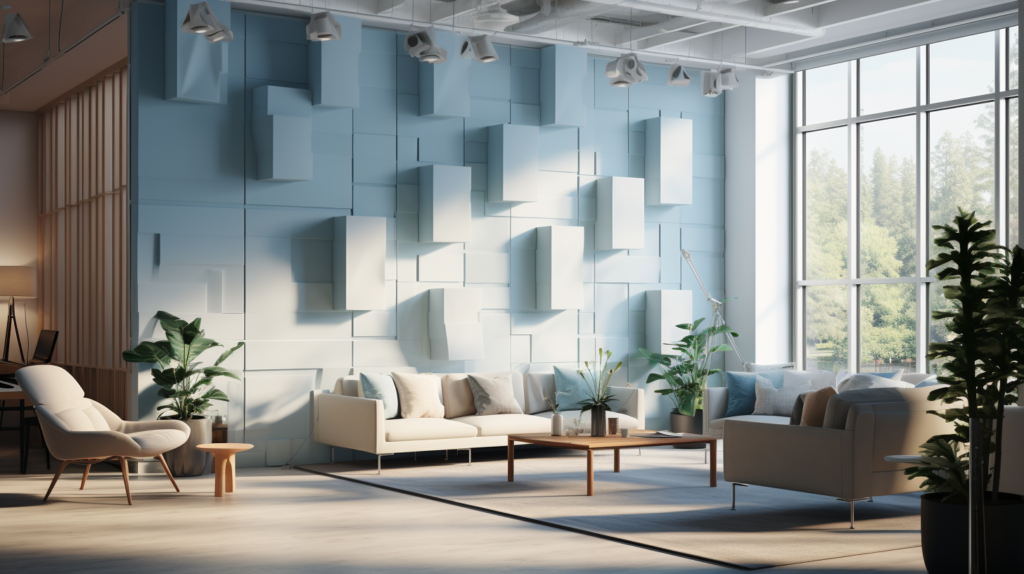
Acoustic panels have a noise reduction coefficient (NRC) rating that specifies their sound absorption capacity at various frequencies.
This NRC number ranges from 0 (no absorption) to 1 (full absorption) based on laboratory testing. For effective noise blocking, look for acoustic panels with an NRC of at least 0.80 or higher.
The higher the NRC, the greater the amount of sound absorbed by the acoustic panel.
Getting Real Noise Reduction
Note that density, thickness, and coverage area will also impact real-world noise reduction.
While acoustic panels will not completely soundproof a room from noisy neighbors, they can make a significant difference in lowering noise levels.
With enough coverage area on shared walls and ceilings, your neighbors’ voices may be reduced to an unintelligible muffle and music to a faint thump.
Still Hearing Some Noise
Impact noises will likely still be audible but softened.
Combining acoustic panels strategically placed on walls and ceilings with other soundproofing methods like mass loaded vinyl or insulation can optimize the noise reduction results.
For loud neighbors, getting both acoustic panels and professional soundproofing may provide the best peace and quiet.
Acoustic Panels vs. Soundproofing
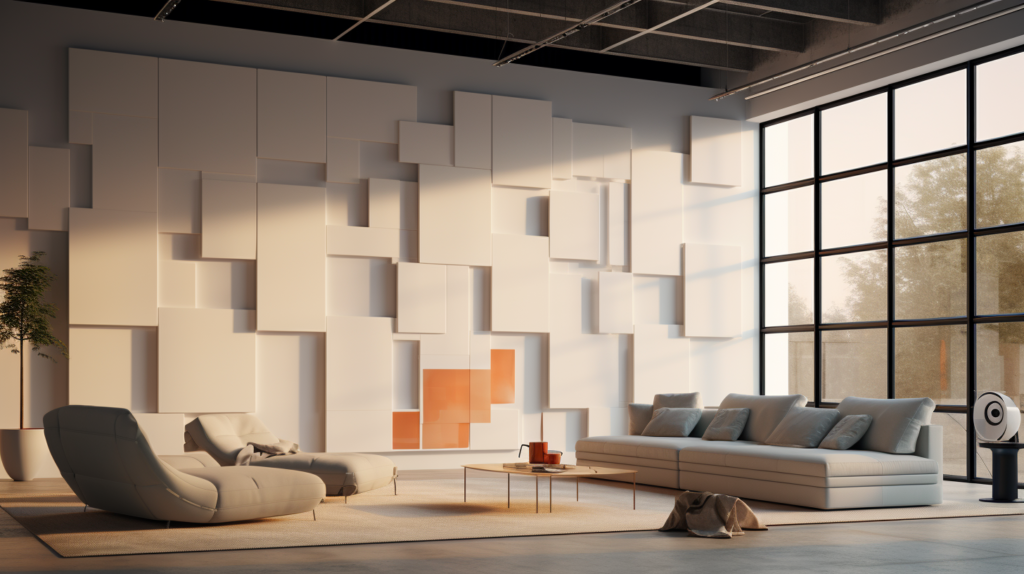
While acoustic panels and soundproofing both aim to reduce unwanted noises, they work in different ways.
Soundproofing materials like mass loaded vinyl physically block sound waves from transmitting through walls, floors or ceilings.
This is most effective for reducing impact noises and very loud noises like music with bass. Soundproofing requires significant construction including sealing gaps and adding mass.
Absorbing vs. Blocking Noise
Acoustic panels, on the other hand, are lighter weight and work by absorbing sound waves rather than blocking them completely.
They are mounted on wall and ceiling surfaces with adhesive or fasteners, so no major construction is required.
Acoustic panels are best suited to absorbing reverberation and reducing general noise levels of mid-high frequency sounds.
Getting the Best of Both Worlds
For a noisy neighbor’s loud music or parties, combining both acoustic panels and professional soundproofing may be the most effective solution.
Strategic installation of acoustic panels reduces reverberation while soundproofing walls blocks impact noise transmission. This balanced approach optimizes noise reduction.
Other Ways To Reduce Noise At Home
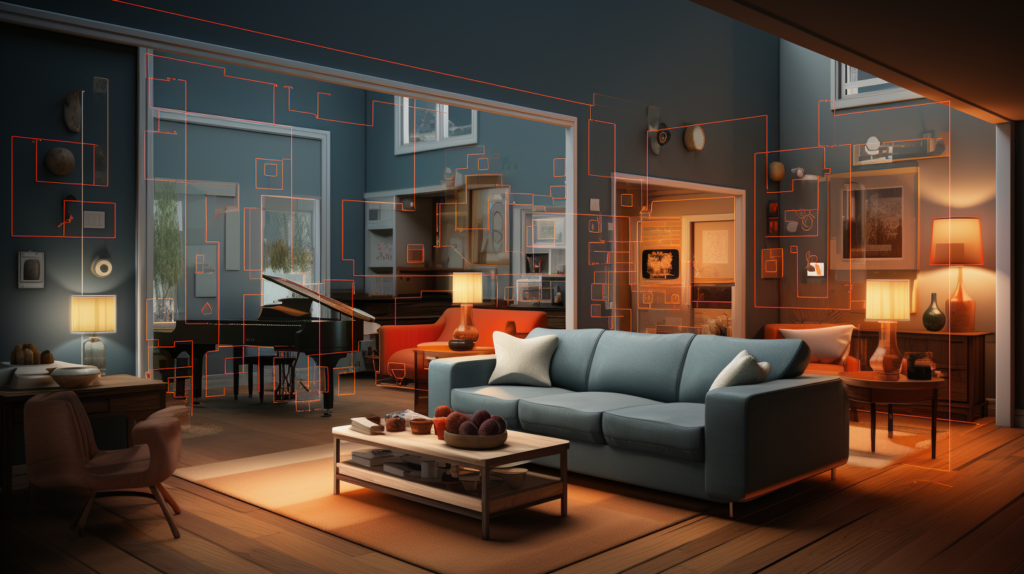
In addition to acoustic panels and soundproofing, there are other simple ways to help reduce noise in your living space.
Adding sound absorptive furnishings like rugs, curtains, and sofas can help absorb some excess noise. The soothing sounds from a white noise machine can also mask unwanted noises.
Caulking cracks around windows, electrical outlets, and other gaps can prevent noise leakage. Properly insulating walls improves sound damping within a space.
Strategically placing furniture to block direct sound paths between you and the noise source can help diffuse noise.
Sealing any exterior door and window gaps with weather stripping reduces the amount of outside noise entering.
Electronic sound masking systems that emit peaceful background sounds can cover up neighbor noise.
A Comprehensive Approach
Combining acoustic treatments like panels with other noise reduction methods provides the best results for improving your environment.
Work with an acoustics specialist for help creating a comprehensive noise control plan tailored to your specific situation and noise sources.
Conclusion
Getting relief from noisy neighbors often requires a multi-faceted approach.
While acoustic panels alone may not completely block loud impact noises, they can provide significant reduction in airborne sounds when strategically installed.
For even greater noise control, combining acoustic panel absorption with professional soundproofing treatments can optimize results.
There are also simple DIY options like adding rugs, curtains, and caulking gaps that contribute incremental acoustic improvements.
With some diligence in identifying major noise transmission paths and addressing them with panels and soundproofing, you can effectively muffle disruptive neighbor sounds.
Experiment with different acoustic panel placements and soundproofing methods to find the right balance that restores your peace and quiet.
Don’t resign yourself to excessive noise—with today’s noise control solutions, you can take steps to significantly improve your home’s environment.
